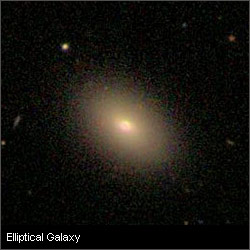|
The Science
What do we want to know?
 Galaxies, made up of billions of stars like our Sun, are the beacons that light up the structure of even the most distant regions in space. Not all galaxies are alike, however. They come in very different shapes and have very different properties; they may be large or small, old or young, red or blue, regular or confused, luminous or faint, dusty or gas-poor, rotating or static, round or disky, and they live either in splendid isolation or in clusters. In other words, the universe contains a very colourful and diverse zoo of galaxies. For almost a century, astronomers have been discussing how galaxies should be classified and how they relate to each other in an attempt to attack the big question of how galaxies form.
Galaxies, made up of billions of stars like our Sun, are the beacons that light up the structure of even the most distant regions in space. Not all galaxies are alike, however. They come in very different shapes and have very different properties; they may be large or small, old or young, red or blue, regular or confused, luminous or faint, dusty or gas-poor, rotating or static, round or disky, and they live either in splendid isolation or in clusters. In other words, the universe contains a very colourful and diverse zoo of galaxies. For almost a century, astronomers have been discussing how galaxies should be classified and how they relate to each other in an attempt to attack the big question of how galaxies form.
For a more general introduction to galaxies - CLICK HERE
Edwin Hubble early last century divided the galactic zoo into two major categories. There are galaxies shaped like rugby balls (or American footballs) which we call 'ellipticals' and whirlpool-like galaxies which we call 'spirals'. More than 80 years later, there is still major controversy among scientists about how these two principal types are even connected in the global understanding of galaxy formation and evolution. Does one type evolve into the other? In theoretical simulations astronomers have found that the merger of spirals can create an elliptical, and that an elliptical can become a spiral by accretion of further stars and gas during its lifetime. Pictures of real galaxies in the sky taken with the most modern telescopes on earth and space reveal that such processes are indeed happening in nature. But how frequent are mergers? Are they really important? Does every galaxy go through such fundamental transformations during its lifetime?
What do we need to do?
 Why don't we just look at galaxies and see how they evolve? Galaxies evolve over billions of years, which is why like evolutionary biologists, we can't just sit there and watch galaxies change. Instead, we need to look at the fossil record contained in the galaxies around us which provides only *one* snapshot of the universe.
Why don't we just look at galaxies and see how they evolve? Galaxies evolve over billions of years, which is why like evolutionary biologists, we can't just sit there and watch galaxies change. Instead, we need to look at the fossil record contained in the galaxies around us which provides only *one* snapshot of the universe.
The way scientists get around this problem is by analysing pictures of galaxies with up-to-date technology in as much detail as possible. Astronomers have spent many decades trying to measure basic galaxy properties such as age, mass or dustiness that may give us some clues as to how they formed and evolved and what precisely the connection between spiral and elliptical galaxies is. However, most studies of galaxies so far have only looked at a few dozen or hundred galaxies in the nearby universe and many aspects of galaxy formation and evolution are still a mystery.
However, with the advent of the 21st century the age of large-scale astronomical surveys has arrived! The Sloan Digital Sky Survey (SDSS) is taking images of a large portion of the sky and will eventually find a million galaxies. With such a large number of galaxies, astronomers can finally begin to understand how they form and evolve by comparing various populations to each other with large enough numbers to draw real conclusions about their origin.
But out of these million galaxies, how do we know which are spirals and which are ellipticals? The answer is simple: look at them! Indeed, until now galaxies have been classified by visual inspection of their images. And in fact, technology is of little help here. It turns out that the human brain is far better than a computer at recognising the patterns that divide ellipticals from spirals. So visual inspection works well for a handful, or even several hundred objects....but one million? There are just too many galaxies for even the most dedicated of astronomers to look at. We need thousands of people to inspect galaxy images and to classify them as spiral or elliptical. We need you to help us.
Continued
>
|